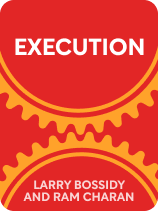

This article is an excerpt from the Shortform book guide to "Execution" by Larry Bossidy and Ram Charan. Shortform has the world's best summaries and analyses of books you should be reading.
Like this article? Sign up for a free trial here .
Are you in charge of hiring new employees at work? How do you know you’re hiring the right person for the job?
In their book Execution, business leaders Larry Bossidy and Ram Charan provide three steps for choosing the right employee. They also explain how to retain your employees after hiring them by supporting their development.
Keep reading to learn how to choose and retain good employees.
Hiring the Right People
The first step to hiring the right person that Bossidy and Charan suggest is to engage in interviews that dig beneath the surface of education, industry knowledge, and past achievements. Ask questions like “If you knew your division would not meet sales goals this quarter, what steps would you take?” or “How do you foster collaboration and open communication among your team members?” This will give you insight into how the candidate makes decisions and how well they will fit into your company culture.
Second, have in-depth conversations with at least two references who you trust to tell you the truth—not only about what someone accomplished but also about how they did it and the skills they used. Pose questions such as “How would you describe their management style?” “Did they nurture their direct reports or alienate them?” “When their department surged in revenue, did that come at the expense of another department?” The authors explain that the answers to such questions will shed light on a candidate’s strengths and weaknesses, as well as the extent to which they prioritize their career growth over company goals.
Third, assess candidates’ work efforts and outcomes. This partly involves reviewing measurable results a candidate produced, such as revenue generated and the number of sales completed. But go beyond quantifiable metrics to also assess their interpersonal skills and adaptability. Bossidy and Charan advise you to consider a candidate’s energy, engagement, and ability to manage a high workload.
| Specific Tools and Action Steps to Identify Top Talent Effective methods for screening candidates and finding top talent have arguably changed greatly since Execution was published in 2002. While the authors’ guidelines are still generally applicable—for instance, it’s still important to avoid promoting unsuitable candidates—here are some more modern innovations that may help you implement their principles more efficiently and effectively: Conducting software-assisted interviews—There are software tools available that generate interview questions for you based on the specific job requirements and help you assess which candidates are better than others. This can save you time on interview preparation and help you reduce bias in your hiring decisions. Using pre-employment assessment tests in place of references—Some experts argue that checking job references is no longer relevant now that social media and simple internet searches reveal so much information about candidates. They also claim that pre-employment assessment tests can fill in any gaps in knowledge about candidates. These tests provide useful insight into how well a candidate is likely to perform in a given role. For example, companies often require candidates for learning and development positions to deliver a teaching demonstration during the interview process. Vetting remote workers—It can be harder to assess people’s efforts when they’re not physically around you all the time. Therefore, you might need to adjust the way you assess remote workers’ work efforts and outcomes to ensure they have equal access to promotion opportunities. In your assessments, be sure to consider a remote worker’s availability to others in addition to their commitment and follow-through. If your staff repeatedly have trouble getting hold of a remote team member, that needs to be resolved before giving the team member more responsibility or leadership. Furthermore, require self-evaluations so remote workers have a chance to make their case for promotion. |
How to Keep People Accountable and Support Their Development
Once you’ve selected the right people for your team, it’s your job as the leader to both hold them accountable and ensure they are continually improving. As Bossidy and Charan remind us, accountability and constant improvement keep everyone making progress toward the goals that matter.
To hold people accountable and ensure their improvement, follow these steps:
Step #1: Make sure everyone is clear about the outcomes every team member is responsible for, their priorities, and the short-term benchmarks they’re expected to hit. That way, say Bossidy and Charan, people can coordinate their efforts to reach the targets that support long-term goals.
(Shortform note: Leaders cannot personally ensure everyone at their company is clear about everyone’s outcomes, priorities, and goals, especially in large companies—a limitation that Bossidy and Charan don’t acknowledge. In Extreme Ownership, Jocko Willink and Leif Babin contend that leaders can only effectively manage about six to 10 people. To acknowledge this limitation and limit your oversight responsibilities, enlist junior managers to keep an eye on groups of team members who you don’t have time to manage.)
Step #2: Follow up rigorously with people in leadership roles so you stay informed about their progress and challenges. Regular check-ins give you an opportunity to offer support, detect risks on the horizon, and adjust plans accordingly.
(Shortform note: In The New One Minute Manager, Ken Blanchard and Spencer Johnson discuss how to perform these touchpoints efficiently through one-minute goal-setting sessions, praising sessions, and redirects that empower and motivate employees. Goal-setting sessions involve the manager and employee defining specific, measurable goals with clear outcomes and deadlines. In praising sessions, a manager delivers specific, positive feedback in real time when they see their employee doing something valuable that advances company goals. In redirects, a manager provides immediate feedback when they see an employee make a mistake, which helps the employee learn from errors.)
Step #3: Have candid performance reviews with direct reports. Clarify what’s working, what’s not working, and what needs to improve—and make sure this is a two-way conversation so you get a clear picture of the challenges and opportunities in play. Then, send a memo after each review that documents any agreements you made during the meeting, next steps, and when the next check-in will be. This, Bossidy and Charan underscore, eliminates confusion about who’s doing what by when.
(Shortform note: Bossidy and Charan don’t address creating sensitive memos specifically related to employee conduct violations or performance issues that emerge during reviews. You can guard against legal complications, such as accusations of discrimination or retaliation, by following standard protocol around documenting violations. Best practices include avoiding statements of opinion and providing concrete examples of violations.)
| Become Masterful at Performance Reviews Delivering good performance reviews takes practice, but you can train yourself to handle feedback conversations in a way that guides employees to pinpoint their strengths and weaknesses. Instead of simply listing off an employee’s recent achievements and issuing directives, focus more on asking questions and engaging employees in thoughtful conversation. Invite them to consider their strengths and future goals and to identify opportunities they see to advance their career interests. Also, encourage them to share success stories from their work, such as an experience that left them particularly energized or inspired. When an employee points to a challenge they’ve encountered, help them begin carving out a solution. Prompt them to consider their desired outcome, what they have tried so far, and what they think might help resolve the problem. This collaborative approach fosters trust and encourages employees to be active participants in shaping their path forward in the company. |
Step #4: Reward people who deliver results and withhold rewards from people who fail to meet expectations. This will reinforce the standards you’ve set and incentivize people to optimize their performance.
(Shortform note: What types of rewards should you give your employees? Rather than offering a generic reward like a monetary bonus, you might consider impressing your employees with a more creative and thoughtful gift. Ideas for creative rewards include reduced prescription drug costs, a thank-you video, movie tickets, or a spa day.)

———End of Preview———
Like what you just read? Read the rest of the world's best book summary and analysis of Larry Bossidy and Ram Charan's "Execution" at Shortform .
Here's what you'll find in our full Execution summary :
- What execution in business is and why it matters
- The three core functions that leaders must perform to execute well
- The three important qualities leaders must have to execute well





